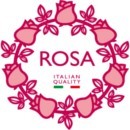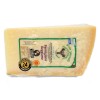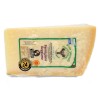The tools used in the production of Parmigiano Reggiano and other curiosities.
In today's post, which ideally completes the previous post about the production of Parmesan cheese, I will tell you about the tools used by the dairyman in the production of Parmigiano Reggiano and other curiosities related to this world.
Are you ready for this new journey?
Here we go!
THE DAIRY
In the past, the dairy was the vital center of agricultural activities in the area linked to the production of Parmesan cheese.
Every day from the areas near the dairy, peasants and children brought the milk to be transformed into cheese.
In the Parma tradition the dairies have a square plan, while in the Reggio area they are polygonal.
But there is also one with a circular plan, in Soragna.
It is unique in its genre and is currently the seat of the Parmigiano Reggiano Museum.
The dairies could be isolated or leaned against a rustic house.
But they all had one trait in common.
Historically, once upon a time, there was a pigsty in their vicinity for breeding pigs.
This is because the excess whey of the cheese was used to enrich the mash that was fed to the pigs.
An example of how the circular economy already existed, before it became the subject of academic study in more recent times.
Curiosity: usually, the dairies inside them retain an image of San Lucio who is the protector of the cheesemakers.
In these devotional images the saint is depicted standing with a wedge of cheese in his hand while he is offering it to a poor man kneeling at his feet.
Legend has it that San Lucio was a shepherd who lived in 1200 in Val Cavargna, on the border between the province of Como and Switzerland.
He took care of bringing his master's herds of cattle to the mountain pastures, milking them and making cheese.
It is also said that he used the caciofiore technique, which uses vegetable rennet instead of animal rennet, to produce a greater quantity.
The excess part San Lucio gave to the poor.
But his master, thinking he was being robbed, kills him on 12 July and throws his body into a mountain pasture pool which, since then, turns red every year on that day.
For the locals this event is a miracle and so San Lucio becomes the protector of all those who make cheese.
At this point, perhaps, you are wondering how the cult of this saint came to Parma from a valley on the border with Switzerland.
Well, you must know that the inhabitants of Cavargna were poor farmers and, during the winter period, to survive they moved to the plains to repair the copper pots and the boilers of the dairies in which the milk for making cheeses was cooked.
And this is how the cult of San Lucio first spreads in Lombardy and arrives in the province of Parma.
THE MILK PATH
After being milked by the farmer, the milk was collected in cans and taken to the dairy, where it was delivered in the bucket hanging from the scales.
If you have read the previous post, you know that to make a wheel of Parmigiano Reggiano it takes 500 liters of milk.
Obviously, in the past, no farmer had at his disposal a sufficiently large number of cows to be able to supply this quantity of milk on his own.
Therefore, in order to make a wheel of Parmesan cheese, the joint effort of several farms was required.
The cheesemaker first weighed the milk given by each farmer and made a note of it in a notebook.
When the farmer reached the quota of 500 liters of milk delivered, he was paid either in money or with a wheel of Parmigiano Reggiano.
After the milk was weighed and recorded, if it was collected in the late afternoon, it was poured into a few circular bowls and left there to rest overnight.
In this way the cream emerged which, the following morning, was removed by the cheesemaker with the spannarola and set aside to make butter.
If the milk supplied was, instead, that of the morning, which is leaner as the cows sleep in the evening and therefore do not eat, the cheesemaker poured it directly into the boiler with the partially skimmed milk obtained with the above procedure.
TOOLS OF YESTERDAY AND TODAY
- The demijohn: used to preserve the whey obtained from the production of Parmigiano Reggiano the day before. In this way, the strain of bacteria necessary for the birth of Parmesan cheese was preserved, guaranteeing continuity.
- The wheel: a long handle with a wooden wheel placed on top, used by the cheesemaker to mix the milk and mix the whey and rennet.
- The spino: it is the tool with which the curd is cut. Originally it was a thorny branch but over time this involved the release of splinters of wood that ended up in the cheese so that, at a certain point, it was replaced by a long stick on the end of which metal rings were placed. This innovation allowed the cheesemaker to speed up his work and to make the texture of the cheese more homogeneous.
- The shovel: used to lift the curd which settles on the bottom of the boiler.
- The ladle: it is used to pour the graft whey.
- The thermometer: used to keep the temperature under control so that it does not exceed certain parameters.
- The spersola: rectangular table, used to place the molds containing the curd, equipped with a groove to collect and drain the excess whey.
- The fascera: used to shape the cheese. Weights are placed on top of it which, with their pressure, release part of the serum.
- The centrifuge: tool used to remove the residual cream from the whey left in the boiler.
- The boiler: originally it was a large copper pot placed on a brick furnace that was fed by bundles of wood that made a direct fire. Subsequently, we switched to a boiler with a double bottom in which the steam flows which makes the milk heat. The introduction of this innovation has allowed greater temperature control and a more hygienic processing of the cheese which is no longer contaminated by foreign elements from the fire such as smoke, ashes and lapilli.
- The salting room: introduced in the nineteenth century (before the salt was passed by hand by the cheesemaker directly on the cheeses, editor's note) consists of a series of tanks full of water that are filled with salt until the solution is saturated. At this point, the wheels of Parmigiano Reggiano are immersed in them in order to release the whey remaining inside them in order to dry the dough.
- The linen cloth: used to lift the curd and transport it into the molds. Linen is used and not cotton since the curd does not stick to its fibers.
- The scalera: shelves where the forms of Parmigiano Reggiano cheese are aged after salting.
- The flaking knife: used by the cheesemaker to open the cheese.
- The hammer: used to examine the wheels of Parmesan cheese. Each wheel is hit and must return a very precise sound. When this does not happen, the shape is discarded because it means that there is a bubble or crack inside. Therefore, it is not possible to apply the brand of the Parmigiano Reggiano consortium and is destined for other food uses (for example, in gastronomy).
- The metal plate: a small element that allows you to trace the manufacturer of a wheel of Parmigiano Reggiano.
- The circular stamp: used to mark the forms with the identification number of the dairy that produced it.
Curiosity: grated cheese was used by the ancient Etruscans and Romans inside amphorae as an additional ingredient for storing wine.
CONCLUSION
I hope that this text of mine dedicated to the tools that allow the cheesemaker to produce Parmigiano Reggiano, one of the excellences of the culinary tradition of Emilia Romagna, and other curiosities you liked.
Don't miss the next articles subscribe to my Newsletter and keep following the blog!
I look forward to seeing you in the next post!
Ciao and bye bye,
Mamma Rosa




